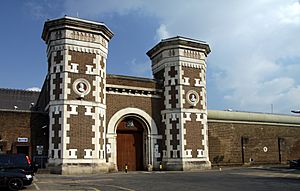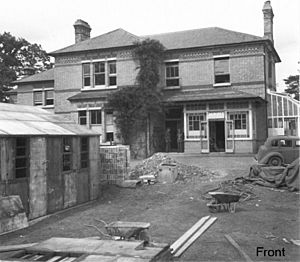MI8 facts for kids
MI8, also known as Military Intelligence, Section 8, was a British military group. It was created in 1914. Its main job was signals intelligence. This means they secretly listened to and understood enemy communications.
MI8 first had four parts:
- MI8(a) handled wireless rules.
- MI8(b) worked with commercial and trade cables from the General Post Office.
- MI8(c) shared information found through checking mail and messages.
- MI8(d) worked with cable companies.
During World War I, MI8 officers were placed at important cable stations. These included Poldhu Point and Mullion in Cornwall, and Clifden in County Galway. This work continued until 1917, when the Navy took over. In World War II, MI8 was in charge of the large War Office Y Group. For a short time, it also managed the Radio Security Service.
Contents
History of Signals Intelligence
MI8 was the signals intelligence part of the War Office. It ran a worldwide network of listening stations called Y-stations. These stations secretly intercepted enemy radio messages.
For about 18 months, from late 1939 to mid-1941, MI8 also ran the Radio Security Service (RSS). This was known as MI8c. However, the RSS was soon handed over to MI6, another intelligence agency. This page mainly focuses on the RSS.
The Radio Security Service (MI8c)
The Radio Security Service (RSS) grew from an earlier group called the Illicit Wireless Intercept Organisation (IWIO). This group was called MI1g. It worked with MI5 and the General Post Office (GPO). Their goal was to find and stop illegal radio transmissions inside Britain.
At the start of World War II, Vernon Kell, the head of MI5, created a plan for illegal radio signals. A new group, the Radio Security Service (RSS), was formed. Major J.P.G. Worlledge led it. His job was to "intercept, locate and close down illicit wireless stations." These stations might be used by enemy spies or others without permission. For security, RSS was given the secret name MI8(c).
Major Worlledge and his team worked from cells at HM Prison Wormwood Scrubs. They chose Majors Sclater and Cole-Adams as assistants. E.W.B. Gill became their chief message analyst. Gill had worked on wireless interception in World War I. He decided it would be best to find the signals from German spy control stations. He hired Hugh Trevor-Roper, an Oxford researcher who spoke fluent German.
Also working at Wormwood Scrubs was John Cecil Masterman. He ran MI5's Double Cross System. This system involved turning captured enemy spies into double agents. Gill used the codes from one of Masterman's agents, called Agent SNOW, to help decode incoming spy messages.
The RSS gave the job of building a large listening network to Ralph Mansfield, 4th Baron Sandhurst. Sandhurst loved amateur radio. He had served in World War I and was a major in the Royal Corps of Signals in 1939.
Sandhurst set up his office in Wormwood Scrubs prison. He contacted Arthur Watts, the head of the Radio Society of Great Britain (RSGB). Watts had worked as an analyst in Room 40 during World War I. He suggested that Sandhurst recruit the entire RSGB Council. Sandhurst did. The RSGB Council then began to recruit members of the society as Voluntary Interceptors (VIs). Radio amateurs were perfect for this work because they lived all over the United Kingdom.
Most VIs were working men who were too old for military service. They worked in their own time and used their own radio equipment. They were told to ignore normal radio traffic. Instead, they focused on harder-to-find, secret transmissions. Each VI had to make a certain number of intercepts each month. If they met this goal, they were excused from other duties, like fire watching. Many VIs also received a special identity card. This allowed them to enter places they thought might be sending unauthorized signals.
The RSS also set up Radio Direction Finding stations. These were in far parts of the British Isles. Their job was to find where the intercepted signals were coming from.
Recruiting Voluntary Interceptors (VIs) was slow. They needed to be skilled, careful, and dedicated. But within three months, 50 VIs were working. They had found over 600 transmitters. All of these were on the other side of the English Channel. It became clear that there were no enemy spies sending signals from the UK. Any German spies who entered the UK were quickly caught. They were either held or "turned" into double agents. These double agents worked under the control of the "XX Committee". Sometimes, a British operator would pretend to be the captured spy and send messages. The German military never realized this.
By May 1940, the RSS had completed its first mission. They had found that there were no enemy agents transmitting from the UK.
Arkley View Headquarters
At first, messages from VIs were sent to Wormwood Scrubs. But as more messages came in, and as Wormwood was attacked by German planes, the RSS needed a bigger place. They chose Arkley View. This was a large country house near Arkley, in Hertfordshire. It was already being used as a listening station. Its secret postal address was Box 25, Barnet. A team of analysts and code-breakers began working there.
MI6 Takes Over
The RSS had become like the civilian version of the military's "Y Service" listening network. By mid-1941, up to 10,000 message sheets were sent to Arkley each day. These were then sent to Bletchley Park, the secret code-breaking center.
In May 1941, the RSS was very successful. Some of its staff had even decoded some German spy codes before Bletchley Park did. Because of this success, control of the organization was transferred. After some discussion, it became the communication and interception service for Military Intelligence, Section 6 (MI6). Before this, MI6 did not have its own listening abilities.
Lieutenant-Colonel E.F. Maltby became the new controller of RSS. From 1942, Lt. Col. Kenneth Morton Evans was the Deputy Controller. Roland Keen, who wrote a book on wireless direction finding, was in charge of engineering. The service had plenty of money. It got a new main radio station at Hanslope Park in Buckinghamshire. This station was called Special Communications Unit No.3 (SCU3). German spy communications were now watched 24 hours a day. The large amount of regular information helped Bletchley Park achieve a great success in December 1941. They decoded the German spy agency's Enigma code. This gave them huge insights into German intelligence operations.
At its busiest in 1943-1944, the RSS had over 1,500 staff, not counting the VIs. Most of them had been amateur radio operators. More than half worked as interceptors. Others investigated many enemy radio networks. This gave important information, even when messages could not be decoded. Few transmissions from German spies escaped the RSS's notice. The RSS often found out about changes in German security procedures before the enemy was even used to them.
After the war ended, the RSS headquarters moved to Eastcote. It then became part of the Government Communications Headquarters (GCHQ).
The Wilton Scheme
The "Wilton Scheme" was a short project from March to May 1945. There were fears that British Prisoners of War (POWs) might be used as hostages by the Germans. Attempts were made to contact the prisoners by radio. The goal was to get information if such a situation happened. In some POW camps, radio amateurs and signal officers had built radio receivers. Some even had transmitters for emergencies. They had been kept updated on war news. However, no contact was made during the Wilton Scheme.




